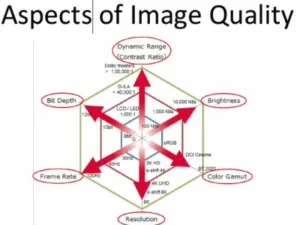
The last speaker in the first session was Rod Sterling, Chief Engineer of JVC Kenwood, who spoke about HDR projection. He pointed out that most of the morning had been spent on flat panels.
Projectors can get up to 1 million to 1 contrast using dual modulation (an image generator and a light source modulator), but you need a good native contrast ratio to give good performance. It’s relatively easy to tonemap for PQ, he said.
It’s 17 years since the first commercial dual modulation projector was produced: the SEOS Zorro, which had 125,000:1 contrast, later upgraded to 1,000,000:1. The Zeiss Velvet planetarium projector goes up to 2.5 million:1 contrast and JVC Visualisation and Reference Series projectors go up to 40,000:1, but they have limited brightness – all are at 2,000 lumens or less.
Sterling looked at six parameters that define a good image.
 This chart highlights the different elements of image quality
This chart highlights the different elements of image quality
He then looked at some of the proposals for HDR, including HDR10, HLG, Dolby Vision and the Technicolor/Philips scheme. At the moment, they are mastering OLED monitors at around 1,000 cd/m², and Dolby has mastered monitors at up to 4K cd/m², but currently there’s no way of mastering at up to 10K cd/m².
Sterling said you can’t consider colour without looking at brightness and gamma, too. He said that one of the problems with Rec 2020 gamut is that different viewers see very pure colours very differently, so you may not need the full gamut. However 2020 is a good way to capture content that is used in a lower gamut (such as P3 – which is the point made by Friedrich).
Turning to HDR, if you want more brightness, you can just turn up the brightness control. That means blocked shadows or blown highlights with SDR, but not if the display is properly designed to work with HDR content.
If your display doesn’t fit the PQ curve, tools have different ways to map to the actual display or to clip the data, Sterling said. How well you map from 2020 to P3 makes a big difference to the quality. It’s not always simple and brightness and metadata are important for a good result.

The eye is made of rods and cones; they work differently and the brain understands the different modes – as shown in the diagram above. You need to take the different modes into account if you are dealing with very high or low levels of brightness.
In AV (rather than making movies), examples of applications for HDR include photo galleries and museum exhibits where images are much more realistic if HDR is used. Automotive design, for example, is difficult in Rec. 709, as, i.e., LED lights can’t be seen (although, as we heard elsewhere at the event, Rec. 709 would be a good start for auto makers). Other applications are aircraft design and cockpits. Indoor lighting can have HDR.
Jewellery design and marketing is an interesting market. Make up is also an application where you want accurate colour and good contrast. Simulators really benefit from having bright specular highlights and Dolby theatres are 1m to 1 with dual modulation.
As a “commercial for JVC”, Sterling said that supporting PQ is not so difficult. You can always shrink down the image to get higher brightness if you are using a projector.
JVC’s LY-HDR36 is a rear projection system that can produce up to 10,000 cd/m² and can be customised to match user requirements.
In response to a question, Sterling said that laser phosphor and lasers help to boost brightness in projection.

